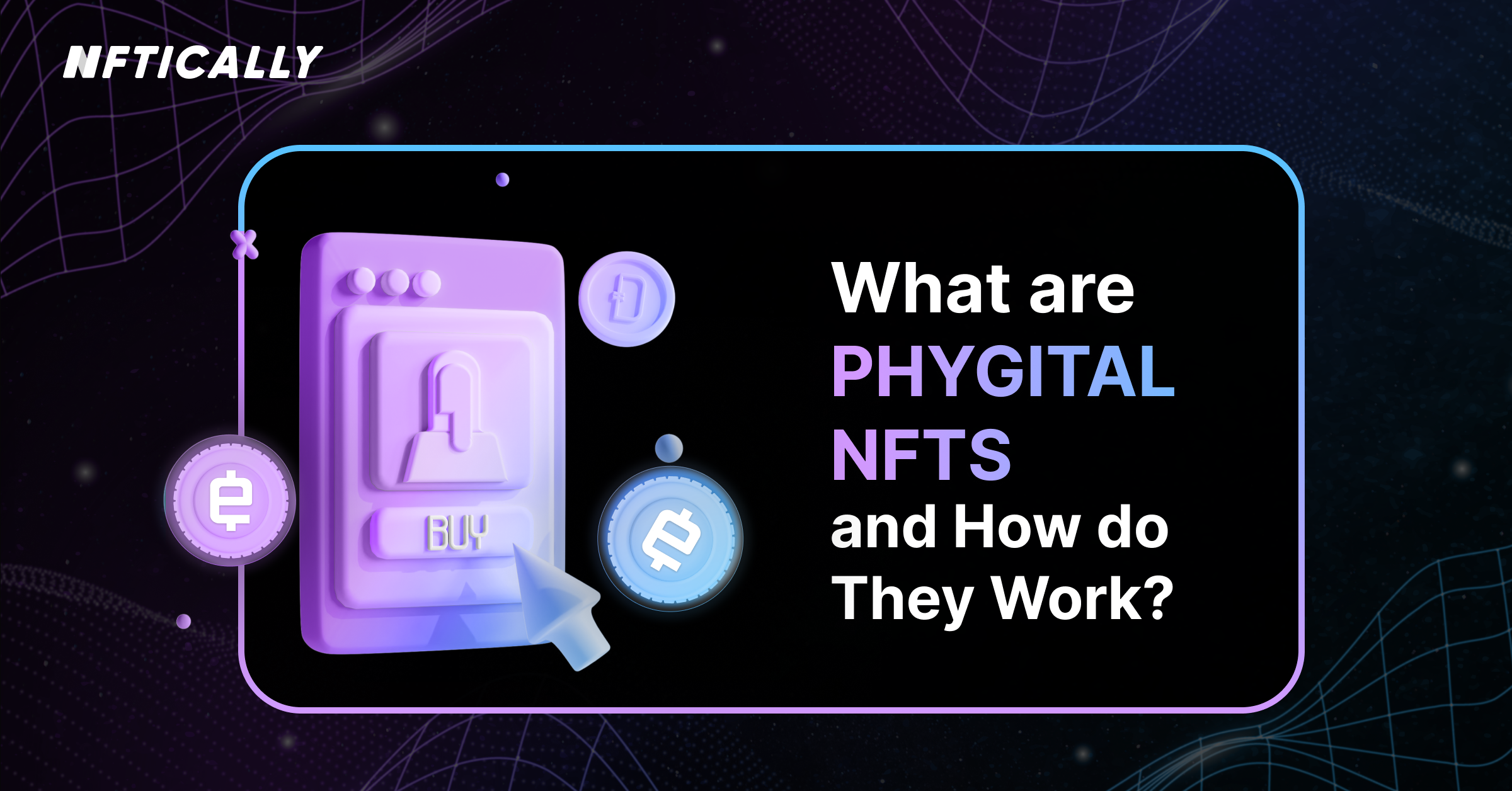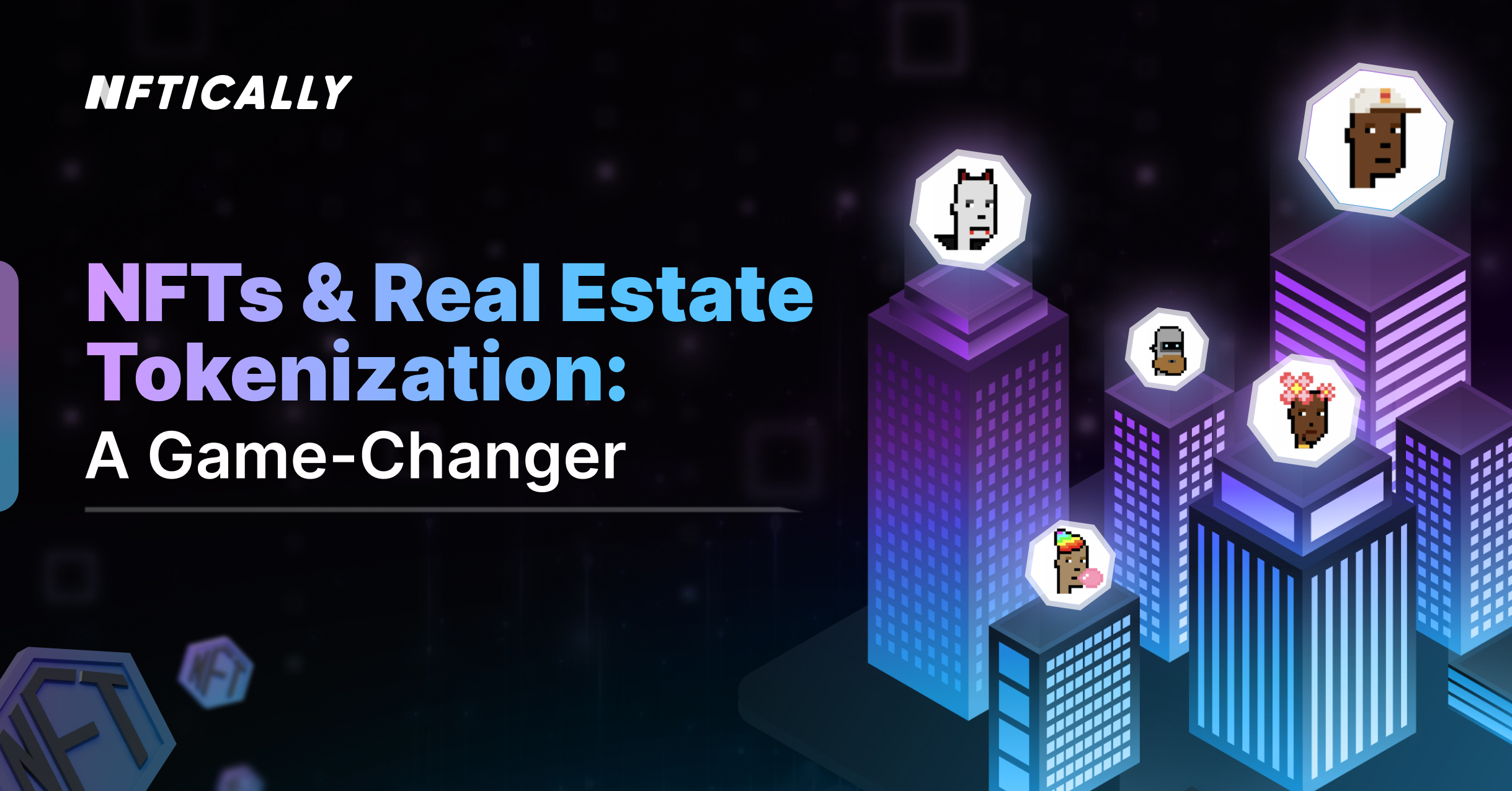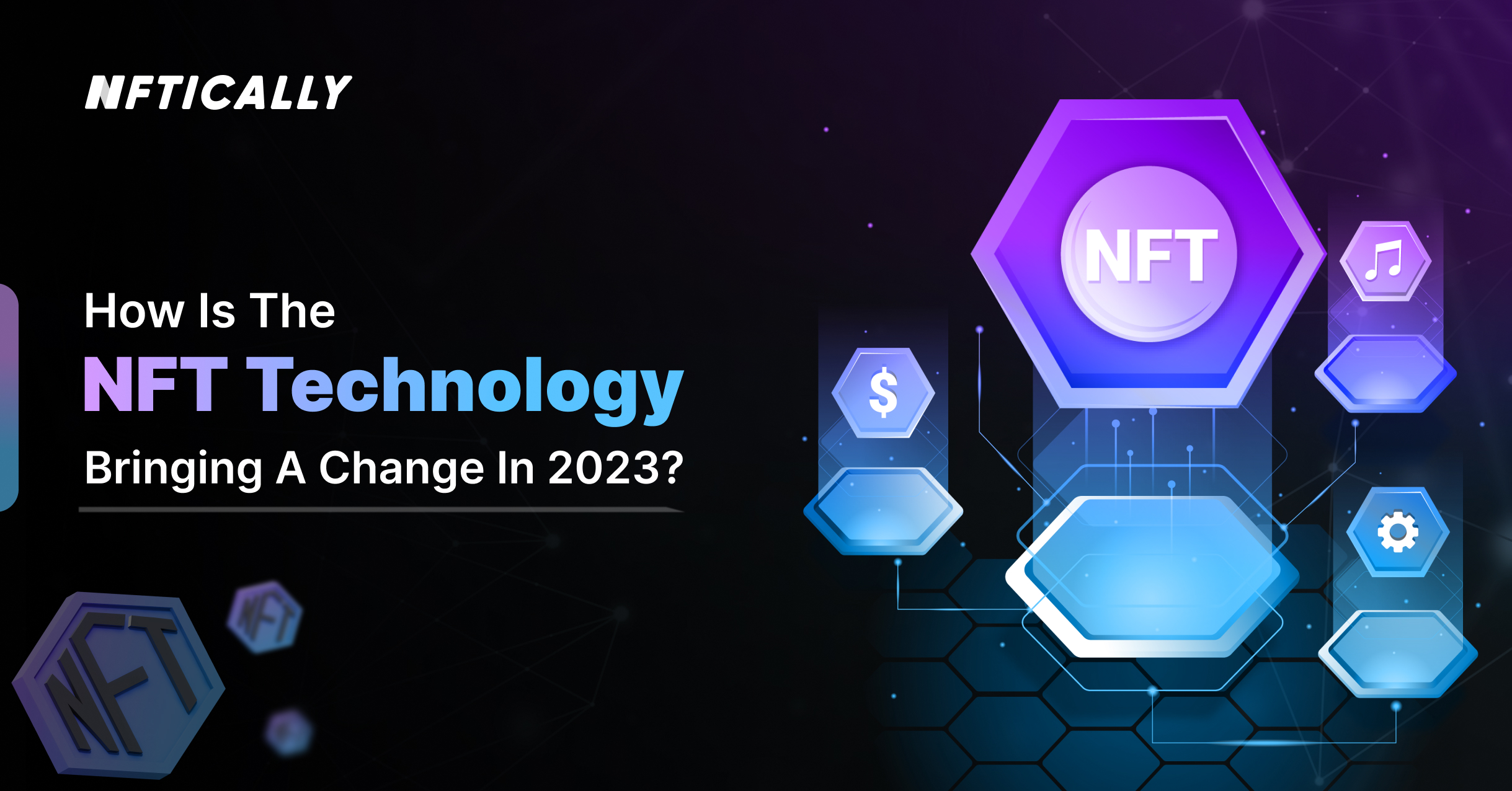- NFT
- February 16, 2023
What are Phygital NFTs and How do They Work

Have you ever wondered how far blockchain applications have come since their inception? They have evolved to become so dominant in the crypto and decentralized ecosystem. From finding applications in the metaverse to representing physical items, non-fungible tokens have come a long way. Now, they are on a new frontier by combining the digital world with physical goods – Phygital NFTs. But, do they really help bridge the gap between physical and digital assets?
If you’re curious about phygital tokens and their role in bridging this gap, then look no further. In this blog post, we will discuss phygital NFTs – what exactly are they and how do they work? So, if you’re ready to learn more about these fascinating tokens, let’s get started!
What Exactly Does the Word “Phygital” Mean?
The definition of ‘Phygital’ explains the fusion of physical and digital experiences. It refers to any product, service, or activity that brings together the traditional physical world with digital technology. It has been a prominent trend in the past decade, as more people are looking for ways to combine the best of both worlds. Non-fungible tokens are a perfect example of this trend. These are digital assets that represent a unique piece of data or artwork and are stored on the blockchain.
The word ‘phygital’ might sound new, but we have already been using it in our daily lives. For example, some stores let you pick up groceries (physical) with an app (digital). Restaurants have menus (physical) with a code that you can scan (digital). You can also get ads from Facebook that are just for people near a certain store. “Pokemon Go” is another example of a phygital. In the game, players find Pokemon characters in the real world with the help of augmented reality (AR) Businesses use this concept to send digital push notifications to people when they’re close to their store and offer coupons. So, phygital experiences are already in use and now this concept is integrated with non-fungible tokens.
What are Phygital NFTs?
The idea behind phygital NFTs is to create an experience that combines physical elements with digital technology. These tokens can represent traditional physical goods, such as art pieces or collectibles, but with a twist. The NFT will exist not only in the physical world but also on the blockchain as an immutable record of ownership and authenticity. This means that collectors can own and store their tokens both physically and digitally, enjoying the benefits of both worlds.
This new form of non-fungible tokens has the potential to revolutionize how we buy and sell physical goods. These are more secure than traditional methods of buying and selling goods because nobody can steal or counterfeit them due to their immutable nature on the blockchain. Non-fungible tokens can also provide enhanced authentication, which means that collectors can trust that the token they are buying is legitimate.
In addition to being more secure, phygital NFTs also offer a greater sense of ownership and connection with physical goods. Holders and collectors can store their tokens both digitally and physically, which can create a unique feeling of ownership. These digital tokens can also create an even closer connection with the physical goods they represent, giving access to view digital information about their tokens, such as their provenance and history.
How do Phygital NFTs Work?
As we discussed, phygital NFTs work by connecting the physical and digital worlds together. The NFT itself is a digital token that exists on a decentralized ledger, such as the Ethereum blockchain. On this ledger, the virtual token will contain all of the information about the asset it represents. This information includes who owns it, what it’s worth, and other important details.
To connect the non-fungible token and its physical entity, it requires a unique identifier. This could be anything from a QR code to an embedded microchip. Whenever we change the token details, for example when we buy or sell it, this change will reflect on its physical counterpart. The updated information also reflects on the digital token’s metadata.
In this way, phygital tokens bridge the gap between the physical and digital worlds. As non-fungible tokens become increasingly popular, they could become the ultimate form of ownership. They allow owners to track their assets easily and securely. It’s an exciting development in the world of blockchain and one that could revolutionize the way people own and manage real-world assets. All these make phygital NFTs stand out from traditional tokens by providing a tangible ownership record for physical items.
Advantages of Phygital NFTs
Phygital NFTs offer several advantages that are not available with traditional digital tokens. First, they allow for better physical interaction between the asset and its owner. These tokens provide a unique way to both authenticate and possess physical objects without having to own them traditionally. This allows for more secure and trustless transactions. Additionally, virtual tokens can also be used to monetize physical objects while retaining ownership rights over the asset.
Furthermore, phygital NFTs can create unique user experiences with physical assets. For example, we can use them to create interactive art installations in public spaces. This would allow users to interact with non-fungible tokens using their mobile phones, which could then unlock additional rewards and experiences. Additionally, they can also create a gamified experience with physical objects. This could include an NFT-enabled scavenger hunt or AR game in which users have to find certain tokens to unlock rewards. Phygital token experiences can also allow brands to reach new audiences and maximize their ROI, while also providing more immersive experiences.
Finally, these kinds of non-fungible tokens can bridge the gap between digital and physical experiences. They provide a unique way for users to authenticate and possess physical objects while also creating an interactive experience with these items. Likewise, phygital tokens can bridge the gap between digital and physical experiences to ensure an optimal balance between both worlds.
Types of Phygital NFTs
Physical Art and Collectibles
Phygital NFTs can represent physical art and other collectibles in innovative ways. They offer artists new opportunities to produce and sell artwork that you can experience both online and in physical form. This non-fungible token can represent a wide range of artworks, ranging from paintings and sculptures to jewelry and apparel. Phygital tokens also represent collectibles such as toys, figurines, and trading cards. They also have the potential to unlock new ways of collecting and generating royalties for artists.
Metaverse Fashion and Merchandise
Metaverse fashion and merchandise tokens are becoming a popular phenomenon in the virtual world. Phygital NFTs represent physical assets, such as apparel and other fashion items, as digital tokens on the blockchain. They allow brands to offer their collections of clothes or other goods within the metaverse.
In addition to fashion, non-fungible tokens can be used to represent almost any type of physical asset, including real estate, multimedia files, stocks, and artwork. Brands such as Nike have already implemented virtual sneaker collections as non-fungible tokens. They are also becoming popular among gamers and individuals who want a digital representation of their favorite items.
Food and Beverage
Phygital NFTs can also represent food and beverage items in the real world. For example, Blockbar offers non-fungible tokens with physical bottles of whisky. The non-fungible token provides proof that it is an original bottle and not a fake copy. When collectors buy these tokens, they get a QR code on the bottle which is connected to their token. This proves that they own the bottle and they can redeem the token for its physical counterpart.
Luxury items
Phygital NFTs can also be used to represent luxury items. For instance, Truefacet, a digital luxury marketplace, has created digital tokens that represent physical jewelry pieces. These tokens provide proof of authenticity and help prevent fraud when buying high-end jewelry. This allows buyers to have the assurance that their purchase is genuine. They can even represent photographs, memorabilia, and other collectibles and blur the line between the physical and digital worlds.
How Can Brands Benefit from Phygital NFTs?
Using non-fungible tokens in phygital activations offers unique advantages to brands over traditional tokens. Here we listed a few of the ways brands can take advantage of phygital NFTs.
1. Nurture customer loyalty: Phygital NFTs provide an opportunity for brands to create a sense of community and reward customers for their loyalty. Brands can also use them to provide exclusive access and discounts on physical goods or services.
2. Generate revenue: Non-fungible tokens offer the potential to monetize customer engagement with unique, one-of-a-kind digital assets that have real value as collectibles. They can also create digital products that customers can buy and sell in marketplaces.
3. Increase visibility: Phygital NFTs offer a unique way for brands to raise awareness of their offerings. This way, they can generate buzz around new product launches and attract more customers. They also provide an engaging platform on which brands can tell their stories in an interesting way.
Overall, phygital non-fungible tokens offer a creative and engaging way to bring customers closer to brands. They can also create memorable experiences that nurture customer loyalty and generate revenue. As technology continues to evolve, more brands will likely jump on board to capitalize on these opportunities.
Final Words
Non-fungible tokens have the potential to redefine the way brands interact with customers and create meaningful experiences. Through phygital non-fungible tokens, brands can nurture customer loyalty by offering exclusive access or discounts. They also offer an innovative way for brands to monetize their products. This is possible through digital assets that represent real value as collectibles. Finally, phygital tokens provide a unique platform where brands can engage with customers in interesting ways and increase the visibility of their offerings. With all these advantages, it’s no wonder why more companies are starting to embrace NFT technology.
Whether you’re a collector, investor, or just looking for an innovative way to engage with your customers, NFTICALLY offers a world of possibilities. So, explore the platform today!
Related Posts

NFTs and Real Estate Tokenization: A Game-Changer
Are you curious about the next major development in the world of non-fungible tokens (NFTs)? Well, it seems that real estate tokenization is poised to become the next big thing in NFTs. Lately, the concept…
- September 22, 2023

How is NFT technology bringing a change in 2023?
Although the crypto market faced some challenges at the beginning of 2022, often referred to as a “crypto winter,” NFTs continued to demonstrate impressive figures. By the end of the year, the total revenue generated…
- May 25, 2023
Recent Posts
- Revolutionizing AI Clones: Sunny Leone Teams Up with Kamoto.AI for an Unprecedented Debut
- The Evolving Landscape of NFTs: A Glimpse into 2024
- NFT Trends to Shape 2024: A Deep Dive into the Future of Digital Assets
- The Gaming Revolution: NFTs Level Up the Player Experience
- NFTs and Intellectual Property Rights: Navigating Legal and Ethical Challenges
Recent Comments
Archives
- January 2024
- December 2023
- November 2023
- October 2023
- September 2023
- August 2023
- July 2023
- June 2023
- May 2023
- April 2023
- March 2023
- February 2023
- January 2023
- December 2022
- November 2022
- October 2022
- September 2022
- August 2022
- July 2022
- June 2022
- May 2022
- April 2022
- March 2022
- February 2022
- January 2022
- December 2021
- November 2021
- October 2021
- September 2021
- August 2021
- July 2021
Categories
- $ECOM
- 3D NFTs
- AI Characters
- Airdrpos
- Bitcoin
- Blockchain
- Blockchain Technology
- Buy NFTs
- Buying
- Crypto Collectibles
- Crypto Wallet
- Cryptocurrency
- Cryto Mining
- Digital Art
- Digital Assets
- Ethereum
- FAQs
- Features
- Generative Art Nfts
- ICO
- Invest in NFT
- Learn
- Metavatars
- Metaverse
- Minting
- NFT
- NFT 2.0
- NFT Art
- NFT Art Finance
- Nft auction
- NFT Communities
- NFT Crypto
- NFT crypto art
- NFT Drops
- NFT Games
- NFT gaming
- NFT Marketplace
- NFT Memes
- nft project
- NFT Royalties
- NFT Staking
- nft stocks
- NFT Store
- NFT Taxes
- NFT Trading Cards
- NFT Wallet
- NFTICALLY
- NFTs
- Non fungible tokens
- Non Fungile Tokens
- Ordinal NFTs
- Physical Assets
- Press Release
- Selling
- Solution
- Stablecoins
- Store
- Tensor Nfts
- Top Cryptocurrencies
- Uncategorized
- Web 2.0
- Web 3.0
- white label nft marketplace

